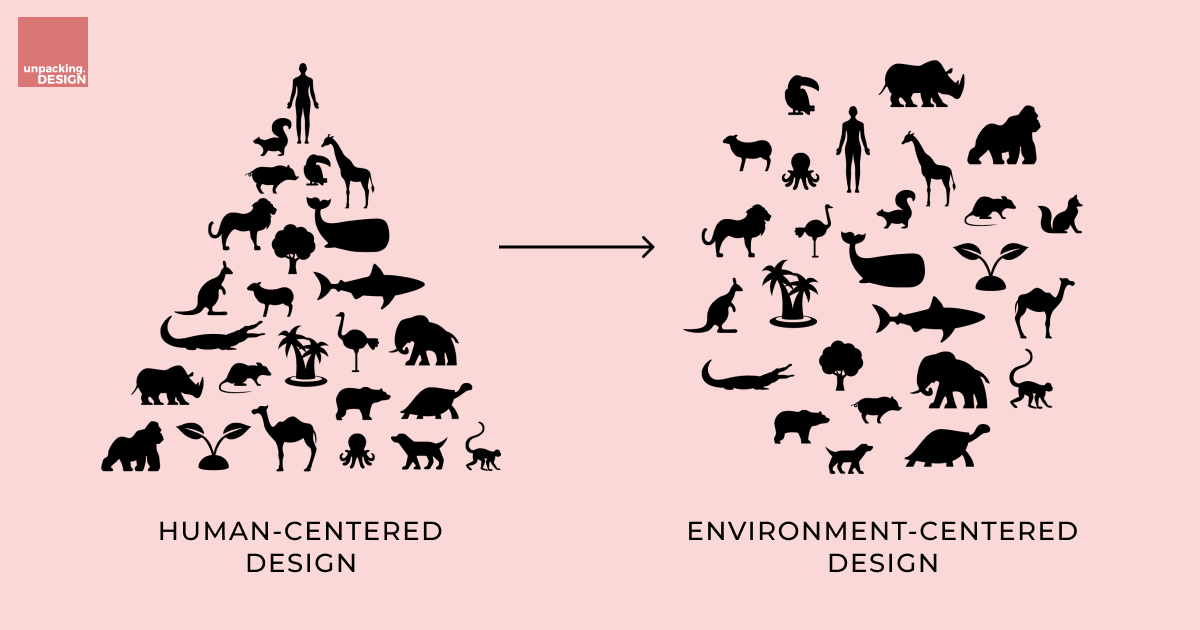Design Matters Tokyo 2023: Planet-centric Workshop

A few weeks ago, Jules Mahé and I presented a workshop at Design Matters Tokyo called “Shifting and shaping – leveraging design skills for planet-centric impact.” This was a little different than our usual design systems workshops. Instead, we were helping designers identify their design superpowers that could be used to help them solve planet-centric problems.
Human-centric design
For decades, we’ve focused on human-centered design, which put humans at the top and the main focus of everything we do. Our inventions, services, products, and so on all go to serve humans. If it’s not directly serving humans, then it’s probably indirectly serving us somehow. While they’ve been incredibly useful for us, they’ve come at a cost to the rest of the planet. We’re consuming finite resources faster than they can be replenished, we’ve destroyed habitats for wildlife, reduced animal populations, we’ve polluted the air, water, and land, and so much more.
Planet-centric design
Many of us recognize this and want to help but aren’t sure where to start. We can start by shifting our mindset from human-centric to planet-centric design. In this view, humans are still part of the planet but aren’t at the top. Instead, they’re amongst animals, plants, natural resources, and more. The idea of designing for the planet doesn’t just consider the main user but considers the impact the solution has on other living and non-living things on the planet.
While planet-centric design might be a new concept, designers don’t have to change their skill sets. The same user-centered and design thinking skills of empathy, ideating, testing, and iterating still apply. Instead, your personas might not be humans, they might be animals, resources, or non-living things.

Getting involved in small, low-stakes ways
While the environmental problems can seem overwhelming, we have a few approaches to navigating how you can participate and make an impact. First, consider an environmental topic you’re passionate about. Is there an ongoing issue in your community? Does something environment-related impact you, your family, or your friends directly? You’re more likely to commit to solutions and endeavors when things are meaningful.
As design system experts, we’re also big proponents of starting small and scaling your efforts. While you might want the world to reduce plastic waste, that’s very ambitious and overwhelming! Instead, we encourage you to start smaller efforts (e.g., leading a design thinking class with kids on inventing non-plastic portable cups or participating in a clean up or challenging your friends to a plastic-free month). From there, you can see what you like, what you don’t, what worked and what didn’t. And if you’d like, you can start to scale your efforts.
We also believe smaller changes can make a bigger difference than taking an extreme route. For example, the average American consumes about 487 pounds of plastic annually. If we asked ten people to eliminate plastic from their lives, we would eliminate 4,870 pounds of plastic. While great, eliminating plastic is really difficult because of how ubiquitous it is. Instead, if we asked 1,000 people to eliminate using 20 pounds of plastic a year, that would remove 20,000 pounds of plastic. While that’s only a 4% reduction, that’s still a lot of plastic. And eliminating 4% of plastic seems much more feasible than 100%. So solutions don’t have to be extreme, they can be small and iterative.
Activities you can try
We had a series of activities in our workshop that we think are useful to individuals or teams interested in using their design talents for planet-centric good.
Our activities included:
- Defining your superpowers
- Identifying environmental concerns or interest areas
- Analyzing your concerns/interest areas
- Brainstorming how you can use your superpowers based on specific aspects of your concerns/interest areas
- Defining a roadmap to get you started on learning more and working toward your planet-centric goals
We set up a Figjam board that contains all of these activities, including explanations on how to use them. You may recognize some of these activities from work – they’re similar, but their context changed a little. Overall, many of the activities and rituals we do at work are also things that can help people and organizations create planet-centric solutions and change.
Keep us posted!
We encourage you to try the activities on the Figjam board. Let us know what you came up with and if you end up working on any projects to help your local community! Please mention us on Twitter or LinkedIn–we love hearing people’s stories and ideas. And the more you can share with others, the more they become inspired to take a planet-centric approach to designing solutions.